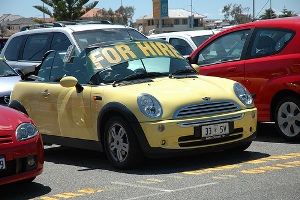Car Rentals in Australia
 Driving in Australia is probably the best way to explore the country and enjoy open spaces. Renting a car allows you to have the freedom of driving wherever you want whenever you want, without having to stick to strict schedules. To drive in Australia, you should be at least 18 years old and have a driver’s license in English. Otherwise, you will need to investigate other modes of transportation in Australia.
Driving in Australia is probably the best way to explore the country and enjoy open spaces. Renting a car allows you to have the freedom of driving wherever you want whenever you want, without having to stick to strict schedules. To drive in Australia, you should be at least 18 years old and have a driver’s license in English. Otherwise, you will need to investigate other modes of transportation in Australia.
>> Rent cars in Sydney
>> Rent cars in Melbourne
Prices and Cars
Although it tends to get quite expensive for a long period of time, renting a car is a good option if you want to explore a particular region or want the freedom of creating your own schedule. The insurance is in included in the price. Remember that it’s quite impossible to rent a car without a credit card.
If you choose to rent when you arrive, remember that the prices tend to be higher at the airport. Hence it’s a better idea to take the public transportation to the city and then rent a car. Pay attention that most companies might add an age surcharge, depending on the vehicle.
Prices aren’t seasonal in Australia. During the entire year, both in Melbourne and Sydney, expect to pay around AUD 60 per day (all fees included) for an economy or compact car. If you are looking for a 4-wheel-drive, you will pay around AUD 140 per day (all fees included). These prices are not much different than those for campervans in Australia, so if you’re looking to save some money on accommodation, those may be the better choice.
Some of the car rental companies in Australia include: Avis, Hertz and Thrifty.
Driving in Australia
 The Australians’ driving habits are not dangerous at all compared to some countries. Everyone (mostly) adheres to the rules. Some of the roads are very long and boring so make sure to make plenty of stops, drink a lot of coffee and share the driving without someone else. The roads are generally well-maintained, but traffic is restricted around the major cities.
The Australians’ driving habits are not dangerous at all compared to some countries. Everyone (mostly) adheres to the rules. Some of the roads are very long and boring so make sure to make plenty of stops, drink a lot of coffee and share the driving without someone else. The roads are generally well-maintained, but traffic is restricted around the major cities.
Remember that traffic drives on the left! So if you come from a country where you drive on the right-hand side of the road, it will take you some time to adjust to the new situation.
A car will take you pretty much anywhere in Australia, but you will need a 4-wheel-drive for beaches and for exploring the outback. However, even though a route might seem pretty clear-cut, it is best to consult a map in advance. There may be a small section that is 4WD only, which can be a big surprise when not expecting it.
The speed limit in residential areas has always been 60 km/h (35mph) but an increasing number of towns are adopting the lower 50 km/h (30 mph) limits. This is the case of all cities in the New South Wales region. On most country roads the speed limit is 100-110 km/h (62-68 mph), although on some highways the speed limit is 130 km/h (81 mph). However, on some highways the speed has been reduced so please ask locally and follow the signs.
Some important road signs and their meaning:
- NO STANDING: you can’t stop except to let a passenger in or off and you can’t park
- NO STOPPING: you can’t stop in the area
- NO PARKING: you can’t park but you can let passengers in or off
- BUS ZONE / TAXI ZONE: exactly what they say, leave that area for buses/taxis
- LOADING AND UNLOADING ZONE: means that trucks, vans or other vehicles that carry cargo are allowed to park if they are loading/unloading.
Extra driving tips:
If you are driving slowly, use the leftmost lane if there is more than one lane in the direction you are going. On a highway, use the left lane unless you are overtaking. Don’t use the horn unless you are in extreme and immediate danger. Seat belts must be worn by driver and passengers all the time. You can park where there are parking meters and have the coins to feed the machines (AUD 1 or 2). The traffic in a roundabout flows in the clockwise direction.
Read more about driving in Australia and sealed vs. unsealed roads.